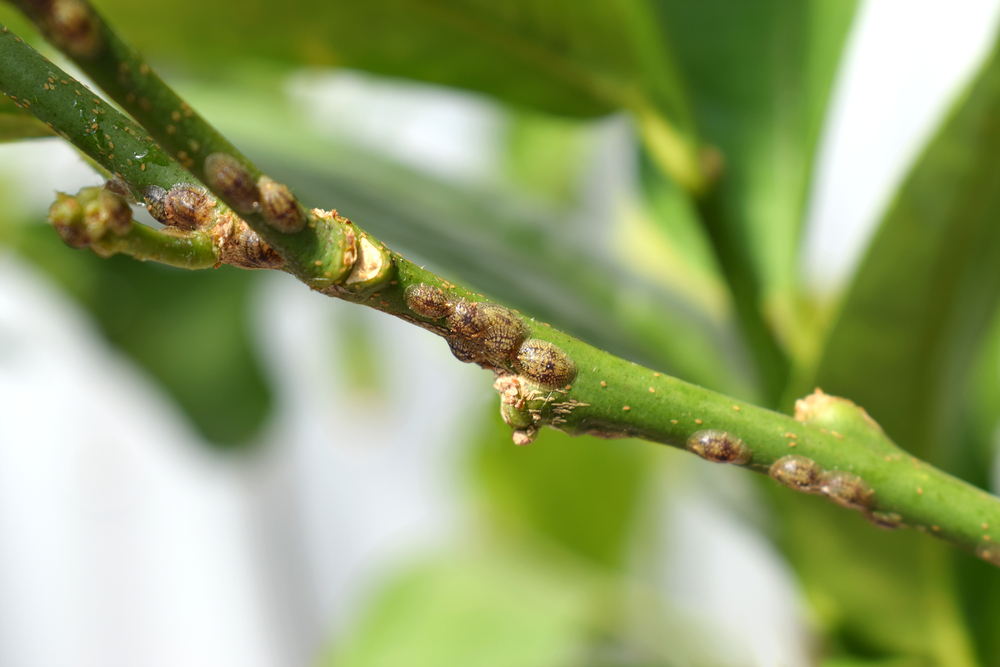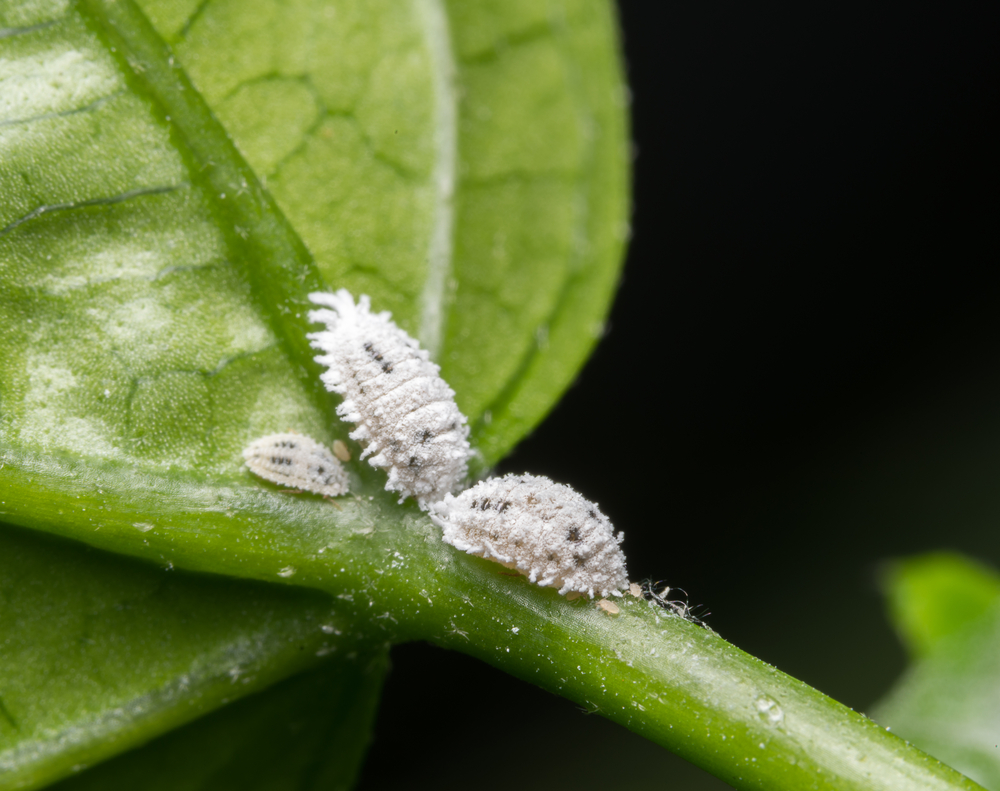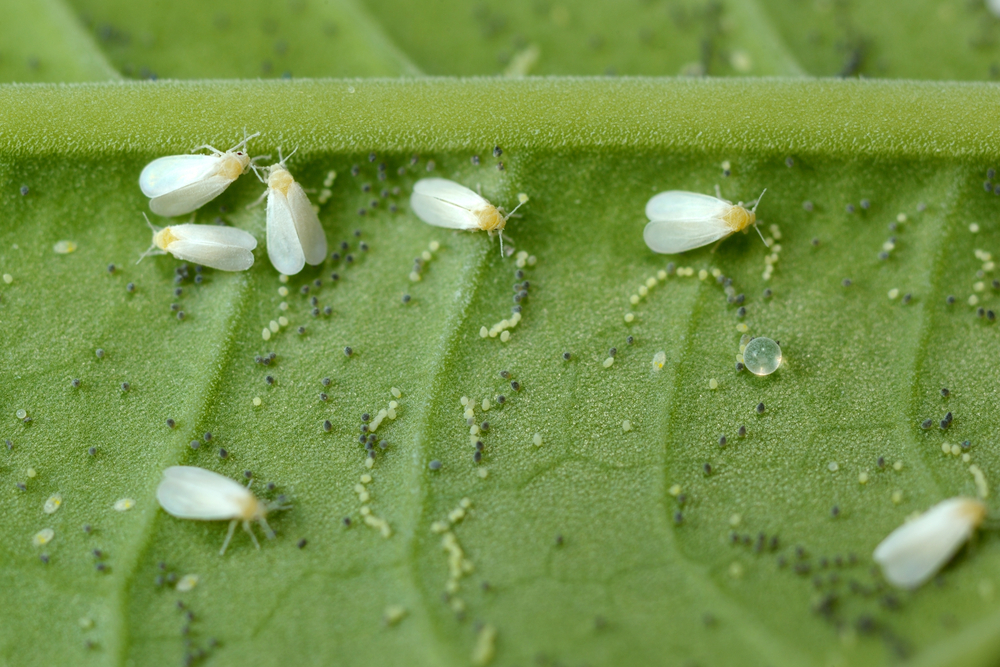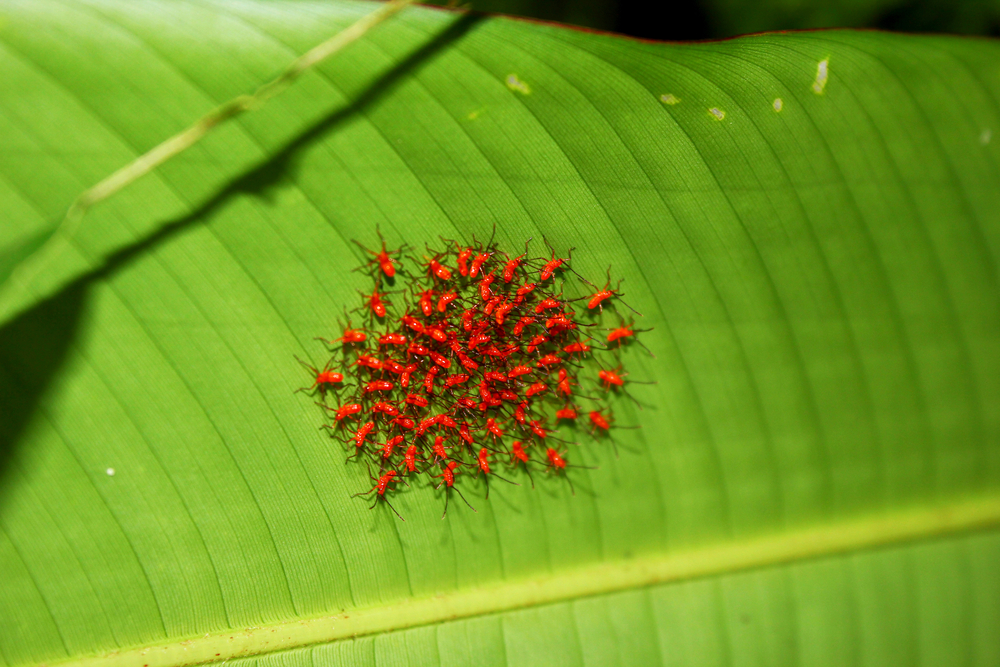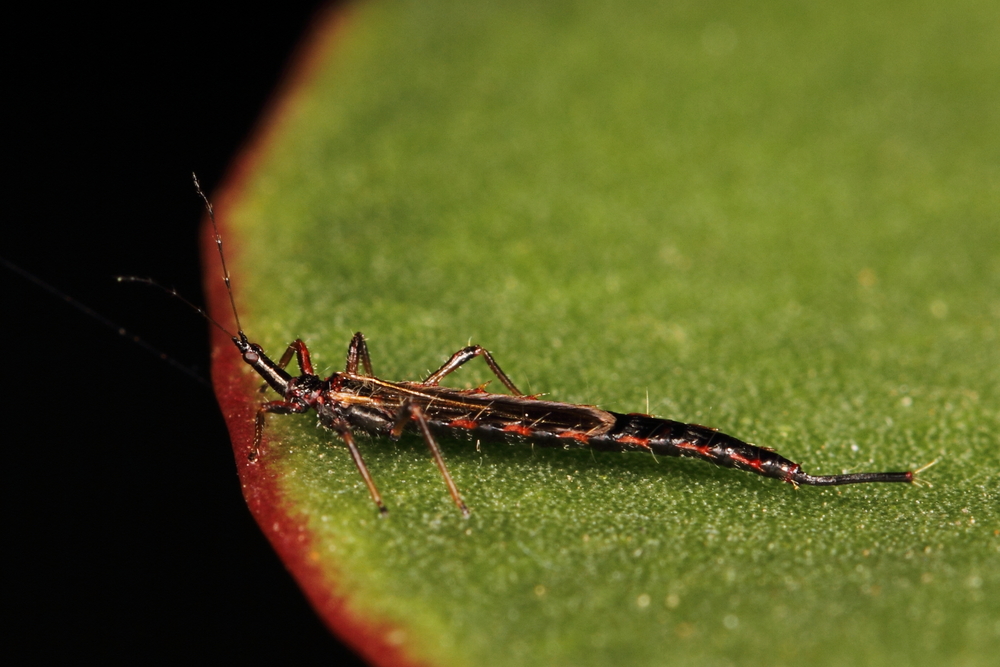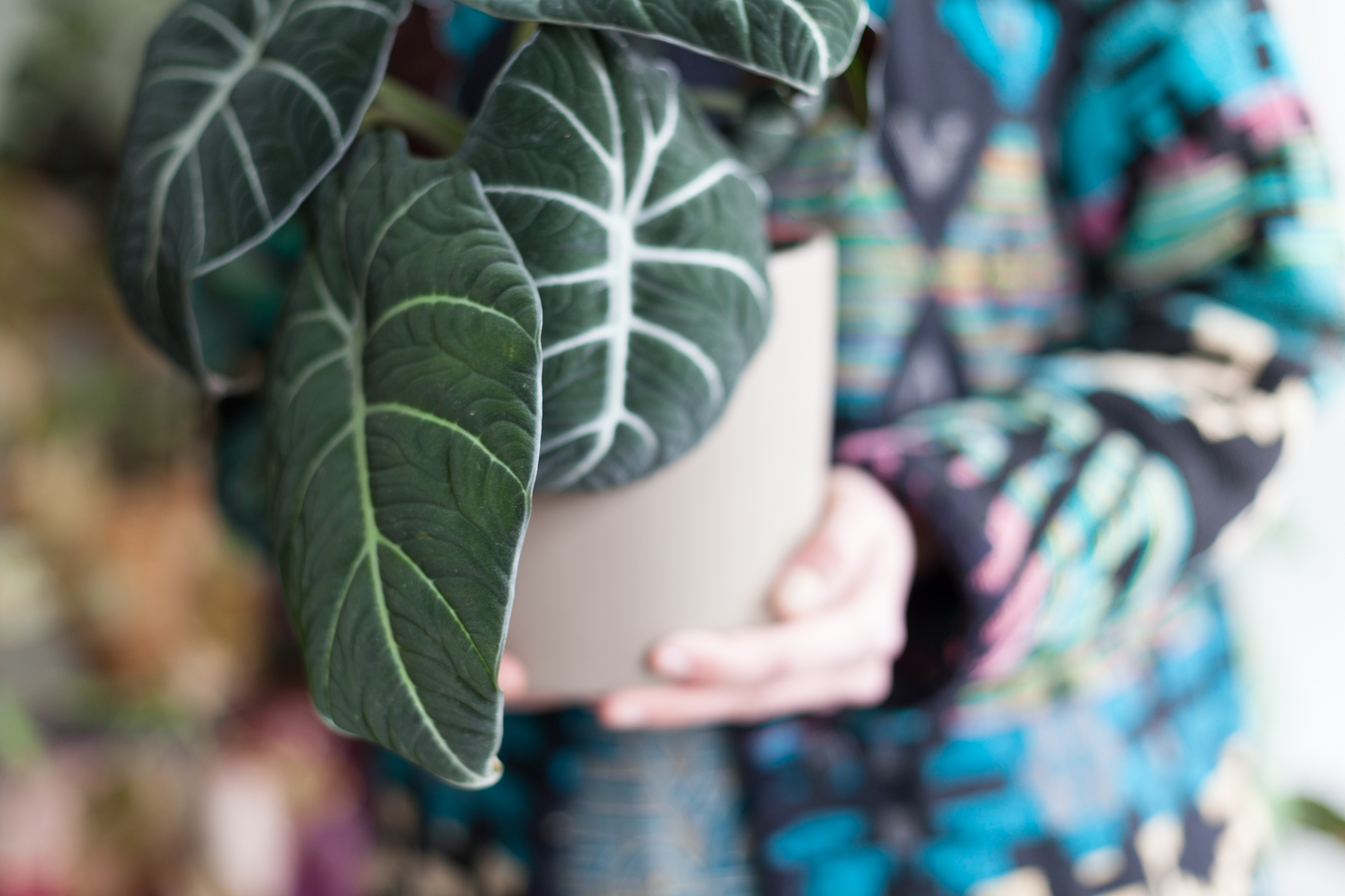As people became more aware of the plants that I was growing in my home, I noticed I would often get the question, "How do you deal with all the insects?"
"All the insects????" I thought. "What on earth do they mean?" I couldn't quite pinpoint the root of their question. Did they assume that benign insects were just generally attracted to flower and foliage—or were they insinuating that I had an outbreak of insect pests? If the latter, I must admit that for the better part of six years I was blissfully unaware of any pesky insects in my home. Not because I'm out of tune with plant and bug (most friends know that I've been raising insects since I was 9 years old and ended up studying entomology in college), but largely because my plants didn't have any noticeable pests.
All of that changed in 2016 when I began growing food in my home. I had converted my closet into a vegetable garden as an experiment and within weeks, the pest numbers exploded. I noticed scale, including mealybugs; whiteflies; thrips; and even the fungus gnat, (the latter which is more annoying than pest-like). As a prolific gardener in an indoor, closed environment, I didn't have any desire to toss out plants or spray toxic insecticides indoors, so I opted for integrated pest management and natural techniques, which I'll go over a little bit here and more in depth in a subsequent post. However, I wanted to use this time to go over some of the common pests that you may eventually get on your houseplants, and simple ways to prevent infestation from the onset.
Common houseplant pests
The list of seven insects and mites are by no means an exhaustive list of houseplant pests, but they are the most typical ones that you'll likely see in the home.
Scale are primarily immobile insects that stick themselves to stems and leaves. They come in two families: Coccidae and Diaspididae. The brown soft scale (Coccus hesperidum L.) shown here is a common houseplant and greenhouse pest.
Common brown scale (Coccidae and Diaspididae families)
The first time I noticed a scale insect was on a jasmine plant that I had purchased at the farmers market. I didn't see the insect at first, but I did notice that some of the bottom leaves of the plant were shiny and sticky. Upon closer inspection, I noticed brown nubs stuck to the woody stem and underside of leaves, closest to the central vein. This was scale.
There are different varieties of scale but by far the most common is the brown soft scale (Coccus hesperidum L.). They are rather inconspicuous—and don't look like a typical insect—unless you know what to look out for. Firstly, they're ovate, only about 3-4 mm long and about half as wide. They can range in color, but are most often brownish in appearance (hence the name), but I've also seen them in shades of yellow, amber, and even olivaceous. They're called "scales" largely due to their scale-like appearance on a plant, due to waxy or armored coverings. They are often seen in clumps along a stem, sucking away at the plant's juices with their spiky mouthpart.
They are only mobile when they are born. Soft scales, which are just one of the groups of scale insects, can reproduce both sexually or parthenogenetically, which means that they can produce young without fertilization. Quite unique in the insect world, the female scales are ovoviviparous, which means they give to birth to living young by hatching the eggs while they are still in their mother. This is the same in Madagascar hissing cockroaches, which are not a plant pest, but an insect that I raise, and I'll be the first to say that it can be shocking that one day you'll have 2 cockroaches and the next day 20X that amount. Same goes for the scale insects. I say this only because you can't really get rid of the eggs unless you get rid of the adults. Once the young, which are called "crawlers" are born, they'll disperse along the plant, find a place they like (usually around some new growth), and literally plant themselves there for the remainder of the time—reaching maturity at around 65 days.
Scale can be a real problem indoors because quite frankly, they have a good temperature year round, which means they'll likely reproduce around the clock. Good news, however, is that scale are, as I shared, relatively immobile, so if they are contained to one plant, then you can control them. Most people choose to discard the plant. Though it was slightly stunted in growth, I decided to keep my jasmine to see if I could revive it. First, homemade soap sprays aren't that effective on scale, partially because the scale on the outside of the insect acts like a shield. You'd want to get it under the cap of the insect.
What I did was as follows:
1. Place a plastic bag or some covering around the soil of your plant. This prevents any scale from falling into your soil.
2. Get a natural, rosemary-based insecticidal soap. Spray this on the plant so it's nice and soapy.
3. Run your fingers along the stems and plant leaves, turning up the scale with your fingernails. If you don't want to touch the insects, you can use an old toothbrush or even a toothpick, but I feel as if I have more control and accuracy with my fingernails. You may notice some scale fall onto the plastic bags; pick them up and discard them. Really be sure to look over the entire plant. My jasmine had a woody stem and the scale looked like part of the stem, so don't be fooled! If helpful, get a pocket magnifier to look over the plant, including the creases of where the leaf meets the stem.
4. After you've sufficiently soaped and scraped the plant, give it a good, sharp spray with your hose or your shower. You'll want to get all the soap off the plant so it doesn't affect growth. Keeping a plant strong, healthy and growing, can often keep insects at bay.
5. Check the plant again for the next three days, making sure that you hadn't missed any scales. If you did, you can repeat steps 1-4. Check again once a week for the two months, just to make certain you got all the little buggers.
Mealybugs are a type of cottony, mobile scale that often can be seen in clumps on your houseplants. They are generalists, and I've particularly found them on everything from my potato plants, succulents, Stromanthe and Plerandra.
Mealybugs (Pseudococcidae families)
I'm not quite sure how mealybugs first got into my home, but I first noticed them on my potato plants that I was growing in my closet garden. Potatoes, particularly the leaves and stems, grow incredibly fast, so I was monitoring them pretty closely. I first planted the potatoes from ones that I purchased in the farmers market and that started growing "eyes". Interesting enough, I had more potatoes that began growing eyes in my fruit basket, and mealybugs would just "show up" on them. Still to this day I'm befuddled by their spontaneous generation.
Mealybugs are an unarmored scale insect, and I personally think they are more difficult to control than the common brown scale. This is for a few reasons. First is the most obvious: mealybugs move. Though its slow movement, if any plant is touching another, there is a chance the mealybug will hitch a ride on a new leaf and spread. Secondly, though their soft, cottony white appearance is quite obvious on a plant, they have a tendency to hide out in the damnedest of places, like the crotch of a plant or in a leaf that has yet to unfurl. Additionally, they have waxy secretions, giving them their cotton-like appearance, which can serve as some basic protection. And lastly, they breed like rabbits of the insect world. Females can deposit around 600 eggs in loose cottony masses, often on the underside of leaves or along stems. The early instars will hatch in about a week and this often causes a population explosion.
As such, it's important to get mealybug populations in control. Some will toss out a plant completely, but I did no such thing. Instead I did a three-pronged effort, involving the release of two beneficial insects—the green lacewing (Chrysoperla carnea) and highly effective, aptly named mealybug destroyer (Cryptolaemus montrouzieri), and also spot treatment using a q-tip and isopropyl alcohol. Dabbing the alcohol directly onto the mealybugs will easily kill them on the spot, but the upside to releasing the beneficial insects is that the insects can often get to places in a plant that you often cannot get, so I believe both methods—at least for me—have worked the best.
Aphids are another plant-sucking insect that often congregate in large numbers. I most often see them on my herbs and I take enjoyment in squishing them between my fingers, since they are full of plant juice. No wonder why some ants like to harvest the sweet goodness coming out of these globulous insects.
Aphids (Aphidoidea superfamily, Aphididae family)
Aphids may very well be the most commonly known unwanted houseplant pests. However, I've only ever seen aphids on the food crops that I grow in my home and never on my tropical houseplants. It may very well be a matter of preference of them, but I think what they're really looking for is that gooey sap that they get from the plant by piercing it with their mouthparts. They also exude a sticky, sweet honeydew from their rear, which often attracts other pests, like ants—or provides a medium for sooty mold to grow on, which essentially spells disaster for a plant, particularly if it's fruiting.
Aphids are a soft-bodied insect, so they're very easy to squish between your fingers, which I typically do. Like scales, aphids are also viviparous, which means they give birth to live young. Aphids are born wingless, but if you see an aphid with wings, it's a signal that the colony got too crowded and they are looking for a new houseplant for which to feed.
The best way to get rid of aphids naturally is as follows: on a warm day, early in the morning take your infected houseplant outside and spray it vigorously with a hose. Be careful not to break the plant if it's delicate or newly growing. This can be done by spraying short, strong bursts. This should knock down the aphid population naturally. Once you're finished, inspect the plant and crush any remaining ones with your fingers. Repeatedly do the hose-spray method for another few days until you see everything is under control. If you find aphids keep on coming back despite your best hosing efforts, I would then encourage bringing in some beneficial insects, particularly green lacewing larvae or ladybird larvae.
Whiteflies (Trialeurodes vaporariorum) closely resemble tiny white moths, but they are closely related to aphids and scales. Like aphids, they produce honeydew from sucking plant juices, which can then attract sooty mold, which can further harm plants.
Common whitefly (Trialeurodes vaporariorum)
At first whiteflies, which are more closely related to aphids and scale, can be mistaken for little white moths or even mealybugs. Unlike their fellow pesky counterparts, they will easily take flight if you disturb them. I first noticed whiteflies in my home when I started growing potatoes indoors (I mean seriously, potatoes indoors brought every pest imaginable!). Whiteflies are more or less generalists when it comes to plants. I noticed that they first were congregated in small numbers on potatoes, but they soon started to alight on my elephant ear plants, which were nearby.
Adults will lay eggs while they are eating (efficient little beasts, aren't they?). Eggs will hatch in less than a week and then their nymphs, similarly to scale, will crawl a short distance, plant themselves, and suck the plant until they go into a resting stage at about the 3 week point. In about four, maybe five weeks, they begin to emerge as adults and the process repeats. As indicated, both the nymphs and adults of the whitefly use their mouthparts to suck juices from plants, which can cause leaves to yellow and fall off prematurely. Additionally, whiteflies, like aphids, exude honeydew, which becomes an attractant for sooty mold. If you allow whiteflies to multiply, then they can attack your plant enough to weaken it.
Whiteflies are attracted to the color yellow, so the best way to catch them is by having yellow sticky traps, blasting the leaves with short bursts of water from a hose, and also introducing a beneficial insect, like a green lacewing, ladybird beetle, or whitefly parasite (Encarsia formosa). All three techniques are highly recommended, in that order.
Red spider mites (Tetranychus sp.)
Mites are technically not insects but they, like insects, are Arthropods. They are probably some of the most feared of the common household insect pests, largely because they are so difficult to get rid of.
Spider mites are nearly naked to the eye. You often need a magnifying lens to spot them, or you may just notice a reddish film across the bottom of the leaves, some webbing, or even some leaf damage, which usually results in reddish-brown spots on the leaf.
Earlier in the year I was gifted an Alocasia micholitaiana 'Frydek', which is a gorgeous velvety green alocasia. I typically always check my houseplants before bringing them indoors, which is a proactive way to make sure no pesky insects are in tow, but you can't always rely on eyesight. Within about three weeks, I noticed some webbing and the start of brown dots on some of the mature leaves. Before mites could spread to the other plants, I took the Alocasia and washed it thoroughly in the shower and made sure the humidifier was on daily. Mites prefer dry conditions, so keeping the air humid and the plant on the wet side (something an Alocasia prefers anyway), was able to save the plant, although it still bears the battle wounds of the mites.
Spider mites also have a range of natural predators, including other mites like Phytoseiulus sp. and generalist predators like minute pirate bugs and lacewing larvae.
Fungus gnats (Bradysia sp.)
I'm including fungus gnats as a common houseplant pest, only because they are common and more of an annoyance to people versus plants. Fungus gnats look similar to fruit flies, and are often mistaken as such. They are pretty feeble fliers and can often be seen circling around soil, particularly if it's fresh, damp compost. Their larvae, which are really the more cause for concern here, prefer to feed on fungi in the soil, which you can only get in moist conditions. They technically can eat plant material, but if the fungi levels are high, they often won't.
I ended up getting quite a few fungus gnats when I started to grow microgreens in a nice bed of compost. The adult gnats will often hang around the soil because that's where they like to lay eggs, but adults are harmless. I basically got some BTI, or Bacillus thuringiensis, which is a natural and safe bacteria that you can sprinkle in the soil and some yellow sticky traps to catch the adults. The problem was solved within three days. Additionally, you can bring in a natural fungus gnat predator, such as Stratiolaelaps scimitus, which is a type of mite.
Thrips (Order: Thysanoptera)
Thrips are technically a less common insect pest, but I've found that they are most prevalent in my household. I believe they first came into my home through either my herbs or one of my friend's plants, and they quickly spread, as thrips are typically generalists, puncturing the outer layer of a plant and creating a silvery discoloration on the plant leaf. You'll also notice tiny little bits of black frass, which is a nice way of saying "insect poop". One of my most prized possessions, an African blue basil (Ocimum kilimandscharicum × basilicum), which is particularly hardy and difficult to find, had been almost fully ravaged by thrips. I had saved a couple cuttings, which have now almost entirely bounced back thanks to the help of some natural predators, including Thrips Predators (Neoseiulus cucumeris) and Minute Pirate Bugs (Orius insidiosus), which I released in tandem with much success. Additionally, adult thrips are attracted to the color blue, so you can also affix blue sticky traps around your plants to curtail the population.
When you first bring home a houseplant, you may want to take a few precautions to make sure that it has no pests that will spread to your other plants. Pictured here, an Alocasia reginula.
Best ways to prevent houseplant pest infestation
There are a number of best practices that you can do to reduce or eliminate the potential for pest infestation in the home. They are by no means "no-fail" solutions, as many plant pests can easily go undetected by the eye, but they are typically sufficient and proactive approaches to help ensure your plants stay healthy.
Inspect a plant before you buy it. There have been a number of occasions where I noticed insects on a plant. If you can and do identify insects, you should tell the plant shop owner or greenhouse owner so that they can quarantine the plant and ensure it doesn't get sold to anyone else.
Use clean pots and potting soil. If you're bringing home a new plant and are putting it in a new pot, make sure that pot was cleaned thoroughly with a diluted soap or bleach solution to ensure there were no disease-carrying agents. Same goes for soil: I typically always get new soil for my plants because there is no telling if there are any leftover eggs overwintering in the soil from previous pests.
Remove any potential pests from the actual soil ball of the plant. Sometimes the plant you bought will have some interesting Arthropods within its own soil. I've often seeing pillbugs (called roly-polys), sowbugs, and millipedes, all which prefer damp, dark, moist environments. These generally won't harm plants, as they largely eat decaying organic material, but in the case of millipedes, they may eat bulbs and tubers. A long while ago, I bought a plant from the flower district in Manhattan and it was infested with millipedes. A natural way to reduce millipede population, if you think it is a problem, is spreading Diatomaceous earth on the soil, which are fossilized diatoms that actually cut the millipedes, or by using nematodes, which over time, breed and replicate within the millipede, eventually killing it. I would say that if you have a few millipedes in your soil, no biggie, but if you see them, you can capture them and set them loose outside.
Isolate your plant from other plants for a few days to a couple weeks. If you want to be extra careful, be sure to isolate your plant for a few days from your other plants, inspecting its leaves and stems everyday. If you think everything checks out, then move it into your intended space.
Don't let other plant's leaves touch the leaves of your new plant. This one is the hardest to do—particularly in my home—if not next to impossible. However, some pests, like scale, can't spread unless they have a "bridge" to get across to the next leaf. 🌿
Don't forget I have a YouTube Channel as well, with some more great insights into plant pests and beneficial predators. Here are two such videos below, and if you haven't yet, subscribe to the channel, as "Plant One On Me" comes out every week!

